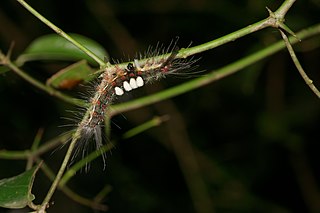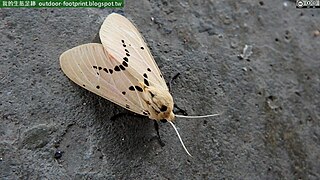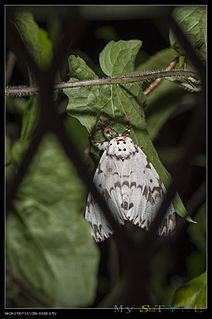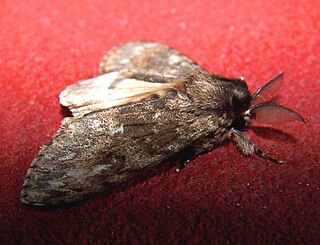
Lymantria dispar, the gypsy moth, is a species of moth in the Erebidae family. Lymantria dispar is subdivided into several subspecies, with subspecies such as L. d. dispar and L. d. japonica being clearly identifiable without ambiguity. Lymantria dispar has been introduced to several continents and is now found in Europe, Africa, Asia, North America and South America. The polyphagous larvae live on a variety of deciduous and coniferous trees and can cause severe damage in years of mass reproduction. Due to these features, the gypsy moth is listed among the world's 100 most invasive alien species.

The Lymantriinae are a subfamily of moths of the family Erebidae. The taxon was erected by George Hampson in 1893.

Utetheisa is a genus of tiger moths in the family Erebidae. The genus was first described by Jacob Hübner in 1819.

The black arches or nun moth is a small Palaearctic moth. It is considered a forest pest.

Lymantria is a genus of tussock moths in the family Erebidae. They are widely distributed throughout Europe, Japan, India, Sri Lanka, Myanmar, Java, and Celebes. The genus was erected by Jacob Hübner in 1819.

Spilarctia is a genus of moths in the family Erebidae. The genus was erected by Arthur Gardiner Butler in 1875.

Lymantria mathura, the rosy gypsy moth, is a species of moth of the family Erebidae found in the Russian Far East, Nepal, Japan, the Korean Peninsula, northern India and China. The species was first described by Frederic Moore in 1866.

Lymantria brunneiplaga is a species of moth of the family Erebidae first described by Charles Swinhoe in 1903. It is found in Sundaland and the Philippines.

Lymantria ninayi is a species of moth of the family Erebidae. It is found in Papua New Guinea.

Lyclene acteola is a moth of the family Erebidae first described by Charles Swinhoe in 1903. It is found in Taiwan and Thailand.

Lymantria umbrifera is a moth in the subfamily Lymantriinae first described by Wileman in 1910. It is found in Taiwan and China.

Scirpophaga praelata is a species of moth of the family Crambidae. It is found in most of Europe, Russia, Turkey, Iran, Syria, Lebanon, North Africa, Japan, Taiwan, China and Australia.

Lymantria dispar dispar, commonly known as the gypsy moth, European gypsy moth, or North American gypsy moth, is a moth in the family Erebidae that is of Eurasian origin. It has a range that extends over Europe, Africa, and North America.

Lymantria dispar japonica, commonly known as the Japanese gypsy moth, is a moth in the family Erebidae of Eurasian origin.

Lymantria serva, the ficus tussock moth or serva tussock moth, is a moth in the family Erebidae. It was described by Johan Christian Fabricius in 1793 and is found in Nepal, Sri Lanka, Assam in India and Yunnan in China. It is possibly also found in Taiwan and Hongkong, but these records might be Lymantria iris.
Alphabaculovirus is a genus of viruses in the family Baculoviridae. Its natural hosts are invertebrates, among them winged insects, and decapods. There are currently 55 species in the genus, including the type species Autographa californica multiple nucleopolyhedrovirus.

Lymantria ampla is a moth of the family Erebidae first described by Francis Walker in 1855. It is found in India and Sri Lanka.
Lymantria detersa is a moth of the family Erebidae first described by Francis Walker in 1865. It is found in India.
Lymantria subrosea is a moth of the family Erebidae first described by Francis Walker in 1855. It is found from Sri Lanka to China and Sundaland, the Philippines, Sulawesi, Seram, the Lesser Sundas to Timor. The Sumatran population is categorized under the subspecies, Lymantria subrosea singapura.
















